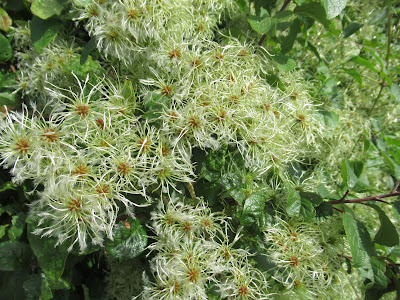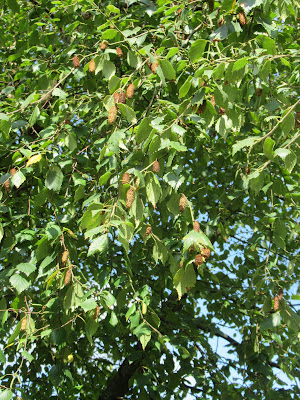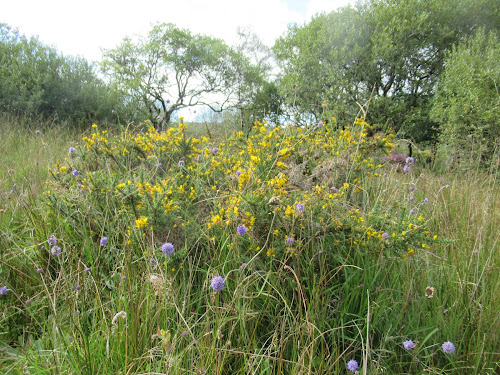SEA-GOING OTTERS & TAME LIZARDS
SEA-GOING OTTERS
Seeing plenty of Otter signs but very rarely a live one at night in our rivers and streams in Cornwall, we were thrilled to see them in the Outer Hebrides some years ago, swimming and fishing among the weedy rocks on the shore during the daytime.
Never in her wildest dreams did Kim think she’d ever see them on the exposed coast on her doorstep in NW Wales.
 |
| Kim's stretch of NW Wales coast, looking across to Bardsey. |
They are quite frequent inland on Pen Llyn, even raiding the fish in garden ponds. They have been seen occasionally as road kill locally and sightings are made where the little River Daron flows into the sea at the nearby village of Aberdaron.
One winter four or five years ago, Kim was sitting on the grass above the sloping slabs of the low cliff looking for the Purple Sandpipers which can be seen along that stretch of coast.

One of the spraint sites on that stretch of the coast.
Smelling a fishy smell she looked around and there was otter spraint on the grass beside her. Since then she’s found spraint at various places along the headland, with well-worn tracks trodden in the fescue grass and possibly a holt in an earthy hollow among the rocks twenty or thirty feet above the sea.
 |
| Possible holt (nest or resting place) among the rocks to the left of the uppermost patch of grass. |
Seeing fresh spraint quite frequently Kim felt certain she would eventually see the Otter itself : one quiet evening last January she was sitting just above the cliff, painting the dusk sky, when she caught sight of an Otter paddling close in, heading towards the rocks below. It had a small fish in its mouth. It swam on the surface with its head up and tail arched out of the water, and dived repeatedly, coming in closer until it disappeared behind the rocks. Presumably it hauled out but there was no sign when she crept along the cliff.
Looking at the contents of the spraint .
Spraint is the otter dropping combined with a sweet-smelling mucus which acts as a territorial marker. Note the fragments of fish bones.
She has found fish bones, scales and vertebrae , tiny crabs and shells including the small Blue-line Limpets which live on the blades of big low-water Laminaria Oar-weed, and also pieces of the pharyngeal teeth of Wrasse. These are grinding tools in the throat of this fish. The shells and crabs were probably eaten by the Wrasse and the fish in its turn, eaten by the Otter.
A small fragment of polystyrene was in one spraint too. Yet another reminder, if such is needed, that waste plastic is entering the food chain.
THE LIZARDS’ TALE
Sitting in a warm little sun-trap in their garden in a sheltered dip in the ground behind the sea-going otter cliffs, Kim and her husband have become accustomed to seeing a very unafraid lizard family basking or feeding on the stone wall alongside their bench.
 |
| The Lizards' usual basking wall. |
I quote from Kim’s notes:
‘She was there last year and re-appeared this year obviously ‘great with child’.
Pregnant female, 13th June'20.
Early in July she disappeared for a couple of days and then reappeared, and on the same wall we saw up to five inch- long babies. They had copper heads, black bodies and tails. Almost immediately one of these infants had lost half of his tail. Since then we have been seeing Mrs with her babies draped over her at times. Sometimes on her own, and also babies on their own and in various combinations with parents. They all bask and hunt along the drystone wall, and on a south-facing turf bank. To get to this they have to cross a grass path and make their way through dense herbage.
One of the babies in August after a skin change.
One day the stump-tailed baby had flakes of skin sloughing off. He must have rubbed this off on stones, as a couple of minutes after scurrying off he reappeared and most of this had gone. His new scales along his body were then brighter, with pale rust spotting on a greeny black ground. His siblings had already shed their first skin.
At the same time there were two adult males. One of these has a large part of tail missing, out of which end protrudes a quarter of an inch of scaleless black new tail. He is greener, with a narrower body and rich yellow beneath. He basks along the same wall and turf bank. The other even greener male hasn’t been seen since June.
Male with stumpy tail re-growing. August.
One day the red ants living on the wall erupted in nuptial flight. Mrs Lizard grabbed and ate nine as we watched. She’d pounce and scuttle off to bash and manage the ant wings in a slightly less open site then prowl back for more.
She also grabbed and ate a Middle-barred Minor moth which I had put out on an egg box on ‘her’ anthill after opening up the moth trap. Later she investigated the egg box again but narrowly missed a Dark Arches which flew in alarm to safety!
They are all accustomed to us. We have to watch our feet as the babies in particular come down onto the paving. Dare not mow the grass.....’
During a brief visit in late September we delighted in watching them still there. The youngsters popped in and out of the holes bored by Teredo Worms in a driftwood log on top of the wall.
One of the youngsters emerging from a Teredo Worm hole in driftwood log. Late Sep'20.
Thanks to daughter Kim for her observations and some of the photos.
Follow her on Instagram for some of her sketchbook drawings: (including currently the Dotterel on 'her' stretch of coast earlier in Sep.)
kim.atkinson257
Other links you may like to see:
https://northcornwallnaturalist.blogspot.com
https://downgatebatman.blogspot.com































